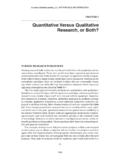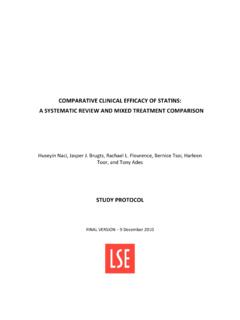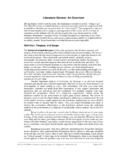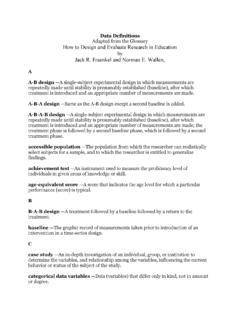Transcription of 8 Integrating Qualitative and Quantitative …
1 6/25/03 12:40 PM Page 165. 8. Integrating Qualitative and Quantitative approaches in Program Evaluation Vijayendra Rao and Michael Woolcock This chapter outlines some of the ways and means by which inte- grating Qualitative and Quantitative approaches in development research and program evaluation can help yield insights that neither approach would produce on its own. In assessing the impact of development programs and policies, it is important to recognize that the Quantitative methods emphasized in this tool kit, while enormously useful, nonetheless have some important limitations and that some of these can be overcome by incorporating comple- mentary Qualitative approaches . An examination of the strengths and weakness of orthodox stand-alone Quantitative (and qualita- tive) approaches is followed by a basic framework for Integrating different approaches , based on distinguishing between data and the methods used to collect them. Some practical examples of mixed- method approaches to program evaluation are then given, and some conclusions drawn.
2 Mixed Methods and Program Evaluation The advantages of Quantitative approaches to program evaluation are well known. Conducted properly, they permit generalizations to be made about large populations on the basis of much smaller 165. 6/25/03 12:40 PM Page 166. 166 VIJAYENDRA RAO AND MICHAEL WOOLCOCK. (representative) samples. Given a set of identifying conditions, they can help establish the causality of the impact of given variables on project outcomes. And (in principle) they allow other researchers to validate the original findings by independently replicating the analysis. By remaining several steps removed from the people from whom the data has been obtained, and by collecting and analyzing data in numerical form, Quantitative researchers argue that they are upholding research standards that are at once empirically rigorous, impartial, and objective. The Case for Integrating Different approaches In social science research, however, these same strengths can also be a weakness.
3 Many of the most important issues facing the poor . their identities, perceptions, and beliefs, for example cannot be meaningfully reduced to numbers or adequately understood with- out reference to the immediate context in which they live. Most sur- veys are designed far from the places where they will be adminis- tered and as such tend to reflect the preconceptions and biases of the researcher; there is little opportunity to be surprised by new dis- coveries or unexpected findings. Although good surveys undergo several rounds of rigorous pretesting, the questions themselves are usually not developed using systematically collected insights from the field. Thus, while pretesting can identify and correct questions that show themselves to be clearly ill suited to the task, these prob- lems can be considerably mitigated by the judicious use of qualita- tive methods in the process of developing the questionnaire. Qualitative methods can also help in circumstances where a quan- titative survey may be difficult to administer.
4 Certain marginalized communities, for example, are small in number (the disabled, wid- ows) or difficult for outsiders to access (sex workers, victims of domestic abuse), rendering them unlikely subjects for study through a large representative survey. In many developing country settings, central governments (let alone local nongovernmental organizations or public service providers) may lack the skills and (especially) the resources needed to conduct a thorough Quantitative evaluation. Moreover, external researchers with little or no familiarity with even the country (let alone region or municipality) in question often draw on data from context-specific household surveys to make broad policy recommendations, yet rarely provide useful results to local program officials or the poor themselves. Scholars working from Qualitative research traditions in development studies like to proclaim that their approaches rectify some of these concerns by providing more detailed attention to context, reaching out to mem- 6/25/03 12:40 PM Page 167.
5 Qualitative AND Quantitative approaches 167. bers of minority groups, working with available information and resources, and engaging the poor as partners in the collection, analy- sis, and interpretation of data (in all its many forms).1. Furthermore, in conducting evaluations, Quantitative methods are best suited to measuring levels and changes in impacts and to drawing inferences from observed statistical relations between those impacts and other covariates. They are less effective, however, in understanding process that is, the mechanisms by which a partic- ular intervention instigates a series of events that ultimately result in the observed impact. For example, consider a community-driven development (CDD) project that sets up a committee in a village and provides it with funds to build a primary school. Even if a per- fect Quantitative impact evaluation were set up, it would typically measure Quantitative outcomes such as the causal impact of the CDD funds on increasing school enrollment or whether benefits were well targeted to the poor.
6 With some carefully constructed questions, one could perhaps get at some more subtle issues, such as the heterogeneity in levels of participation in decisionmaking across different groups, or even more subjective outcomes, such as changes in levels of intergroup trust in the village. Nevertheless, the quanti- tative analysis would not be very effective at describing the local politics in the village that led to the formation of the committee or the details pertaining to deliberations within it: How were certain groups included and others excluded? How did some individuals come to dominate the process? These are what are called process issues, and they can be crucial to understanding impact, as opposed to simply measuring it. Qualitative methods are particularly effec- tive in delving deep into issues of process; a judicious mix of quali- tative and Quantitative methods can therefore help provide a more comprehensive evaluation of an intervention. Qualitative approaches on their own, of course, also suffer from a number of important drawbacks.
7 First, the individuals or groups being studied are usually small in number or have not been ran- domly selected, making it highly problematic (though not impossi- ble) to draw generalizations about the wider population. Second, because groups are often selected idiosyncratically (for example, on the basis of a judgment call by the lead investigator) or on the rec- ommendation of other participants (as with snowball sampling procedures, in which one informant say, a corrupt public official . agrees to provide access to the next one), it is difficult to replicate, and thus independently verify, the results. Third, the analysis of Qualitative analysis often involves interpretative judgments on the part of the researcher, and two researchers looking at the same data may arrive at different interpretations. ( Quantitative methods are 6/25/03 12:40 PM Page 168. 168 VIJAYENDRA RAO AND MICHAEL WOOLCOCK. relatively less prone to such subjectivities in interpretation, though not entirely free of them.)
8 Fourth, because of an inability to con- trol for other mitigating factors or to establish the counterfactual, it is hard (though again not impossible) to make compelling claims regarding It should be apparent that the strengths of one approach poten- tially complement the weaknesses of the other, and vice versa. Unfor- tunately, however, research in development studies generally, and program evaluation in particular, tends to be heavily polarized along Quantitative and Qualitative methodological lines. That is largely because researchers are recruited, trained, socialized, evaluated, and rewarded by single disciplines (and their peers and superiors within them) that have clear preferences for one research tradition over another. This practice ensures intellectual coherence and quality control but comes at the expense of discouraging innovation and losing any potential gains that could be derived from Integrating dif- ferent approaches . We are hardly the first to recognize the limita- tions of different approaches or to call for more methodological pluralism in development research indeed, notable individuals at least since Epstein (1962) have made pathbreaking empirical contri- butions by working across methodological What we are try- ing to do, however, is to take the strengths and weaknesses of each approach seriously and discern practical (if no less difficult) strate- gies for combining them on a more regular basis as part of the over- all program evaluation exercise (see also Kanbur 2003 and Rao 2002).
9 4 What might this entail? Distinguishing between Data and Methods in Program Evaluation A possible point of departure for thinking more systematically about mixed-method approaches to program evaluation is to distinguish between forms of data and the methods used to collect them (Hentschel 1999). This distinction posits that data can be either Quantitative (numbers) or Qualitative (text), just as the methods used to collect that data can also be Quantitative (for example, large representative surveys) or Qualitative (such as interviews and obser- vation), giving rise to a simple 2 2 table (figure ). Most devel- opment research and program evaluation strategies call upon quan- titative data and methods or Qualitative data and methods (that is, the upper right or lower left quadrants), but it is instructive to note that Qualitative methods can also be used to collect Quantitative data as is seen in the detailed household data reported in Bliss and Stern (1982) and Lanjouw and Stern (1998) from a single village in 6/25/03 12:40 PM Page 169.
10 Qualitative AND Quantitative approaches 169. Figure Types of Data and Methods Methods Quantity Subjective welfare Standard Household Survey Quality Quantity Data Ethnography Economic anthropology RRE, PRA (Participatory econometrics). Small-N matched comparisons Quality Source: Adapted from Hentschel (1999). India over several decades and that Quantitative methods can be used to collect Qualitative data as when open-ended or subjec- tive response questions are included in large surveys (Ravallion and Pradhan 2000, for example), or when Quantitative measures are derived from a large number of Qualitative responses (Isham, Narayan, and Pritchett 1995, for example). Other examples from development that fall into this latter category include comparative case-study research, where the number of cases is necessarily small, but the units of analysis are large (such as the impact of the East Asian financial crisis on Korea, Thailand, and Indonesia). Having made this distinction, it is instructive to consider in more detail the nature of some of the Qualitative methods that are avail- able to development researchers before exploring some of the ways in which they could be usefully incorporated into a more compre- hensive mixed-method strategy for evaluating programs and pro- jects.

















